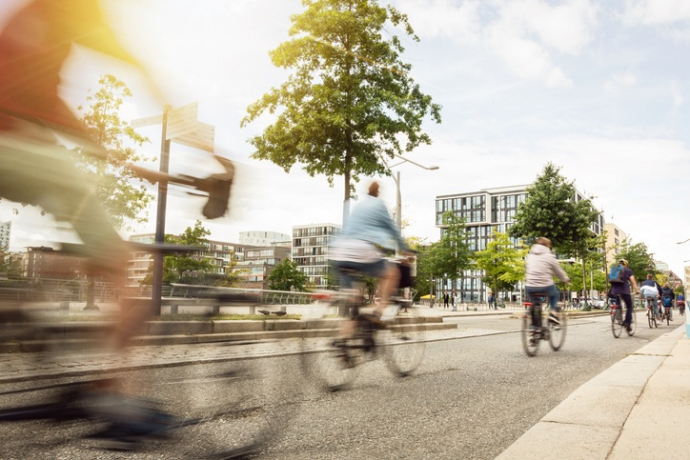
Motoring journalist James May has told listeners of Radio 4’s Today programme that he’s supportive of changing the default speed limit to 20 mph, conceding that ’30mph does feel too fast’ in the area of London where he lives. It’s a sentiment that would have raised eyebrows from May’s co-presenters on Top Gear, but may be a reflection of changing attitudes. Even Jeremy Clarkson may be on the road to Damascus after admitting earlier this month that he drives at 46 mph on country roads, causing long tailbacks in the process.
A speed limit of 30 miles per hour applies to all single and dual carriageways with street lights, unless there are signs showing otherwise. However, local councils are free to set their own speed limits in certain areas. For example, 20 mph zones are becoming commonplace in built-up areas and near schools.
"30mph does feel too fast"
James May, presenter of The Grand Tour, tells @MarthaKearney that he thinks the default speed limit should be changed to 20mph but there also needs to be a 'change in attitude' from motorists#R4Today pic.twitter.com/zjttaVQYNu
— BBC Radio 4 Today (@BBCr4today) January 30, 2023
20 mph limits are crucial for walking and cycling
We can dream about the widespread dedicated cycle infrastructure, interconnected public transport and pedestrianised zones that are now standard practice in the Netherlands, but given we’re already 50 years behind the Dutch approach, pragmatism demands we push for 20 mph limits.
According to Erik Teteroo, a transport planner who advises the Dutch ministry of transport and environment; “The UK is, in some sense, 50 years behind the Netherlands. If you look at what we’ve achieved over those 50 years and what you’re facing now. You’re still facing a very high number of casualties, but you’re also facing, as we had in the 70s with the oil crisis, a global problem with the climate. The climate issue urges for less carbon dioxide, less car use and more alternative like cycling.”
As the Dutch have discovered over the last half century, 20mph zones not only reduce casualty figures, they improve quality of life by transforming streets into areas where people are happy to cycle and children are able to play.
Here at the ETA, we’re proud to have helped coin the phrase Twenty’s Plenty and thrilled that over the years it evolved into 20’s Plenty for Us, a campaign group we continue to support.
Given the number of deaths and serious injuries on our roads, there is no justification for 30 mph as the national speed limit. According to 20’s Plenty for Us, “The 30mph limit that was plucked out of the air in 1934 as being better than no limit, is no longer fit for purpose. It is unjust, unjustifiable and needs to be consigned to history.“
There is no doubt that 20mph limits have numerous benefits. London has seen a 50 per cent reduction in the number of children killed or seriously injured on 20mph roads (see British Medical Journal)
We need more than a ‘change in attitude’ from motorists
In his interview this morning, James May talked about the need for a change in attitude from motorists. We couldn’t agree more. However, talk of ‘culture change’ is sometimes shorthand for ‘everyone just needs to share the road’, which in turn can be doublespeak for ‘I still want to drive when and where I want’.
Make no mistake – the only way to reduce road harm, foster more walking and cycling, and improve air quality is to reduce the number of car trips and in particular the 25 per cent of all car trips that are under 1 mile.
Likewise, the proliferation of street signs May mentions is not a good example of how engineering can help make roads safer. At present, the layout of many streets in the UK facilitates inappropriate speeds. By contrast, good road design encourages safer behaviour rather than relying on the goodwill of drivers.
The ethical choice
The ETA was established in 1990 as an ethical provider of green, reliable travel services. Over 30 years on, we continue to offer cycle insurance , breakdown cover and mobility scooter insurance while putting concern for the environment at the heart of all we do.
The Good Shopping Guide judges us to be the UK’s most ethical provider.

Keith
“…he drives at 46 mph on country roads, causing long tailbacks in the process.”
Not sure how driving MUCH FASTER than the speed limit is going to cause tailbacks…
Mark
It’s struck me for a long time that the main reason people oppose 20mph limits is they think it will make their journeys longer, whereas some simple maths proves it makes little to no difference.
Here’s a scenario taking the “worst possible” conditions of 20mph zones to demonstrate:
There will hardly ever be more than 1 mile to drive through a 20mph zone to reach a 30mph or higher speed main road, so let’s say the journey starts and ends with 1 mile at 20mph vs current 30mph.
> 1 mile at 20mph takes 3 mins (60/20)
> 1 mile at 30mph takes 2 mins (60/30), saving 1 minute so 2mins for the journey.
Of course, that is if you could average 30mph, which, as it’s a maximum speed and there will be traffic, traffic lights and other obstacles so that’s impossible. In reality, it will be much more likely to get close to 20mph average in a 20 zone than 30mph average in a 30 zone.
This also ignores the fact that traffic tends to flow better on a well-designed 20mph street than on a 30mph street, often decreasing journey times.
So the theoretical maximum time saving would be 2mins/journey, but in reality it’s likely to be well below 1 minute. Is that amount of time saving really worth it for the added danger, pollution, and anti-social impacts keeping people off their residential streets?
I certainly don’t think so.